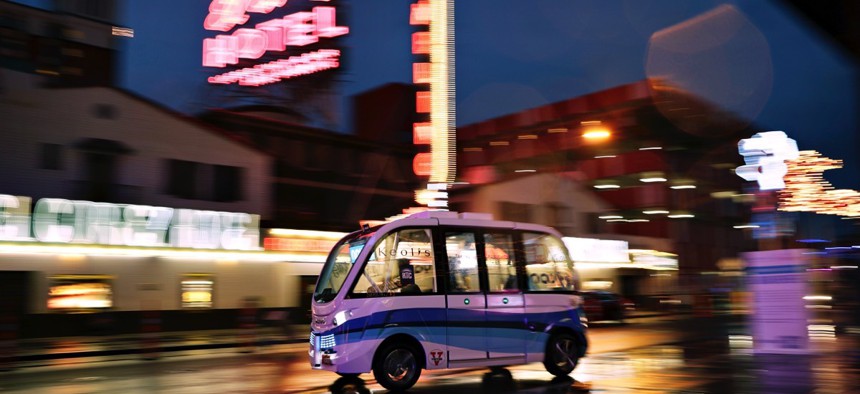A City Data Collaborative for the Age of Autonomous Vehicles

The Navya Arma autonomous vehicle drives down a street in Las Vegas. John Locher / AP Photo
ARGO Labs want to do for California public works agencies, what it did for water utilities—prioritize services and, in this case, road repairs.
California’s recently passed Road Repair and Accountability Act, also known as Senate Bill 1, includes $26 billion for local initiatives that a budding collaborative wants to see spent on data-driven street management.
Streets Data Collaborative is the brainchild of New York City-based data infrastructure startup ARGO Labs, which pioneered the model in 2014 with the California Data Collaborative consisting of 14 water utilities stewarding use of the resource during a five-year drought. Water managers were organized around shared data resources given their fragmented nature.
StDC shifts that paradigm to “equitable and efficient urban mobility” at a time when cities are bracing for autonomous vehicles to take to the streets.
By moving public data more effectively, the thinking is transportation infrastructure repairs can be prioritized and streamlined.
ARGO Labs made its test case developing a Street Quality Identification Device that attaches to vehicles and measures and photographs street quality. Potholes can be counted using an open source hardware platform based on images shot every second, while accelerometers gauged bumpiness and pavement conditioning.
The process is far more scientific than the 1970s “windshield survey” that many cities still perform by eyeballing street conditions and assigning them a score, Varun Adibhatla, one of ARGO’s founders, told Route Fifty by phone. That scoring determines how billions of dollars in local infrastructure funds is allocated.
As CaDC is for water managers, so StDC can be for public works managers with SQUID as a service coupled with identification and refinement of cities’ outlying GIS data. Cities can also invest in cheap sensors for providing real-time, location-based transit data.
StDC also promises to prep cities for the “autonomous future.”
“One very concrete example: Let’s say we do achieve the vision of autonomous vehicles. What does a public autonomous vehicle look like?” Adibhatla asked. “Shouldn't it be able to visit all streets in a city?” Today's technology for routing vehicles through city streets is closed-sourced and expensive to undertake. An open-source approach can benefit not only autonomous vehicles but also existing municipal vehicle fleets.
Another challenge StDC is working on is incomplete street maintenance data. 3-1-1 “complaint” data helps to identify pesky potholes, but providing cities with the means to conduct frequent street surveys is far more efficient—as opposed to the current “whack-a-mole” process, Adibhatla said.
In the short term, StDC is offering California cities the chance to make better use of the SB 1 money they can apply for. The collaborative met with the Los Angeles Bureau of Street Services, which oversees 28,000 lane miles using three laser trucks costing hundreds of thousands of dollars to profile streets.
Identifying which streets are degrading the fastest aids proactive maintenance, and smaller cities experience street maintenance issues more acutely. Patch and sealing streets when the need arises is far cheaper and less intensive than reconstructing them once they’re too far gone.
“There’s an interesting analogy here about street maintenance often being the most visible indicator of local government performance,” Adibhatla said.
He also remains skeptical of how quickly AVs will ultimately be adopted given the “fairly contentious” relationship between Pittsburgh and Uber. And in 2016, a Volvo AV prototype struggled to identify lane markings on L.A.’s street pavement, leading the American CEO to gripe at Mayor Eric Garcetti.
“It’s the responsibility of the city now to maintain these streets so autonomous vehicles can operate,” Adibhatla said. “And we haven’t really seen that before.”
Editor's note: This article has been updated to clarify some language related to "windshield surveys" and correct a quotation about autonomous car routing.
Dave Nyczepir is a News Editor at Government Executive’s Route Fifty and is based in Washington, D.C.
NEXT STORY: Governments, car companies must resolve their competing goals for self-driving cars






